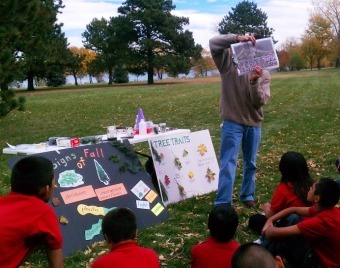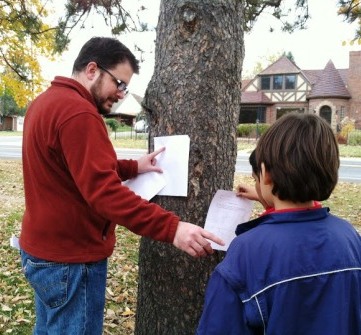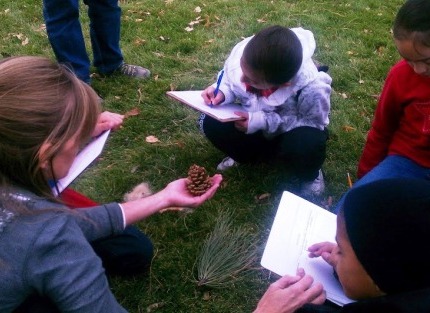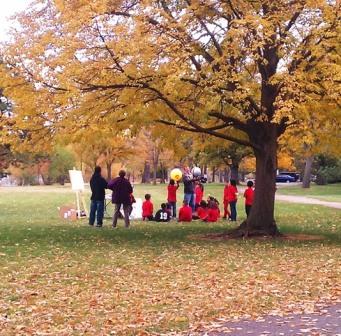 Multiplication usually results in ending up with more than you had at the start. That’s what happened with Environmental Learning Multiplied, or ELM, a program tat Sloan’s Lake Park in Denver.
Multiplication usually results in ending up with more than you had at the start. That’s what happened with Environmental Learning Multiplied, or ELM, a program tat Sloan’s Lake Park in Denver.
ELM is a collaboration of Colfax Elementary School, Denver Parks and Recreation, Colorado PLT, the Colorado State Forest Service, and the Education Department at Metropolitan State University (MSU) of Denver, where I am an education professor. About 20 preservice teachers in MSU Denver science methods classes who attended a PLT workshop had the opportunity to plan and deliver PLT activities at Sloan’s Lake Park a month later. Students in grades 4 and 5 from Colfax Elementary walked to the park, only two blocks from their school, on a Friday afternoon; 2nd and 3rd graders participated the following Monday.
Multiplied Benefits

- MSU Denver preservice teachers planned and delivered hands-on science lessons to children;
- Colfax Elementary students, many of whom are English language learners (ELL), learned about ecosystems and became more familiar with a neighborhood green space;
- Colfax Elementary teachers observed how their students behaved and learned in an outdoor environment, and saw how PLT activities engaged the students with hands-on science activities involving collaboration, critical thinking, observing, and investigating.
- Denver Parks and Recreation fulfilled their objective to promote local parks to the community for recreation and education;
- Colorado PLT discovered how well the program worked and plans to repeat and possibly expand it in the future.
Adapting a Good Idea from Texas
Colorado PLT Coordinator Shawna Crocker brought back the idea for “multiplying” the learning from a PLT International Coordinators’ Conference. She attended a presentation by Cheryl Boyette, Texas PLT Steering Committee, John Boyette, Texas Forest Service and PLT Co-Coordinator, and Alan Sowards, Stephen F. Austin State University, about a program in which preservice students plan and conduct PLT lessons at the university arboretum during an annual Bugs, Bees, Butterflies and Blossoms festival.
In our case, we took advantage of MSU Denver’s existing relationship with Colfax Elementary through our Center for Urban Education, as well as the close proximity of Sloane’s Lake Park to the school.
MSU Denver offers five sections of methods classes—three undergraduate, one master’s, and one in early childhood—as one of the last courses taken before student teaching begins. One of the course requirements is to teach a science and a math lesson in the field, observed by a methods professor.
 Finding time to teach a science lesson in a field experience can be challenging, given the amount of time devoted to literacy and math in the elementary curriculum. But PLT activities are a great way to incorporate teaching science with math and language arts. Thus, ELM provided a way for MSU students to fulfill a class assignment, and the opportunity to partner with a local elementary school and engage students in learning outside.
Finding time to teach a science lesson in a field experience can be challenging, given the amount of time devoted to literacy and math in the elementary curriculum. But PLT activities are a great way to incorporate teaching science with math and language arts. Thus, ELM provided a way for MSU students to fulfill a class assignment, and the opportunity to partner with a local elementary school and engage students in learning outside.
I contacted Joanna Martinez, Colfax Elementary principal, about the possibility. Always interested in finding new experiences for her students, she jumped at the idea. She asked us to involve 2nd through 5th graders. I set up a general agenda for two field days for two hours each day, from 12:30 to 2:30 pm.
The Role for Preservice Teachers
Preservice teachers attended a PLT workshop and signed on for ELM. Their assignment: work in pairs to plan and deliver a PLT lesson to students in a given grade level.
The MSU Denver students had three weeks to plan their lessons. They visited the site beforehand to become familiar with its location, layout, and resources. They were given the following broad guidelines, after which they told me which PLT activities they planned to teach (see ELM Choices below):
- Each lesson would last about 50 minutes, and they would teach the lesson twice in the two hours;
- Both of their classes would be the same grade;
- They would need to supply their own materials;
- Colfax Elementary students would have clipboards, but there would be no tables or seating available.
ELM Days
In addition to MSU faculty and Parks and Recreation employees, Colorado PLT staff were on hand to assist with both field days. The preservice teachers attended only for the day they were assigned to teach. On Friday, the preservice teachers met the 4th and 5th grade classes at the edge of the park, but the Colfax principal asked the preservice teachers to meet the younger children at the school on Monday and escort them to the field site. This allowed for a small orientation beforehand, and the children settled in more quickly once they got to the site.
 We were fortunate that the autumn weather was warm and the golden leaves remained on the trees. Students rotated from station to station with excitement and purpose.
We were fortunate that the autumn weather was warm and the golden leaves remained on the trees. Students rotated from station to station with excitement and purpose.
The preservice teachers found the experience positive but also challenging, mainly because they received little background information about the students or content connections to what they were learning in the classroom. Several of my fellow methods professors came to observe their students, but concluded that the experience did not necessarily reflect their students’ teaching abilities. In this scenario, the preservice teachers’ role was more of a guest speaker than of a familiar teacher. This is a limitation of the program design, and we relied on the Colfax teachers to help tie the experience to prior knowledge learned in the classroom.
Some of the Colfax teachers, especially the ELL teachers, became quite involved in the lessons. We are hoping that they will all become more comfortable with PLT and outdoor learning as we repeat the program in the future. Similarly, if we continue to offer a multi-grade program, students will have multiple exposures from year to year.
All of our experience feeds into our Lessons Learned to keep in mind for our next ELM.
Lessons Learned
While all partners were pleased with ELM, I have thought about ways to improve it:
- Set up the assignment sooner. I would talk to the other professors who teach methods courses so they can include the assignment in their syllabi.
- Work more closely with Colfax Elementary teachers. Ideally, the preservice teachers would correlate the PLT lessons more closely with what the elementary students are learning at that time. It would be great if the teachers could provide some information beforehand, as well as extend the PLT learning afterwards.
- Understand the limitations of the assignment. Some professors came to observe their students at the park. While this is a great experience for the preservice teachers, it is not necessarily an accurate reflection of their teaching ability.
If you are looking for ways to engage preservice teachers, consider a version of ELM that works for you. You will multiply the benefits to your students and the community.
ELM Choices
During ELM, MSU preservice teachers selected these activities to use with Colfax Elementary students:
Second grade
#78, Signs of Fall
#22, Trees as Habitats
#47, Are Vacant Lots Vacant
Third grade
#61, The Closer You Look
#64, Looking at Leaves
Fourth grade
#22, Trees as Habitats
#68 and #78, Name that Tree; Signs of Fall
Fifth grade
#36, Pollution Search
#63, Tree Factory


